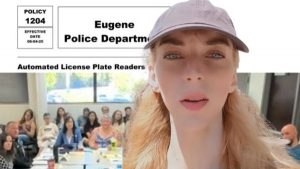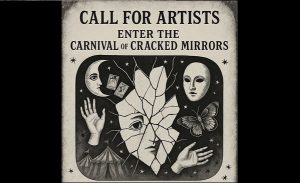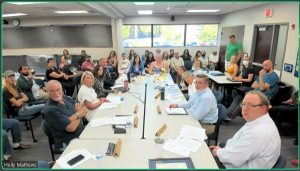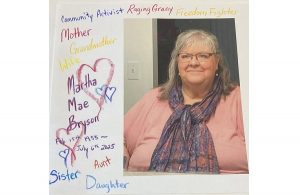3 Upper Willamette SWCD positions up for election in 2024
9 min read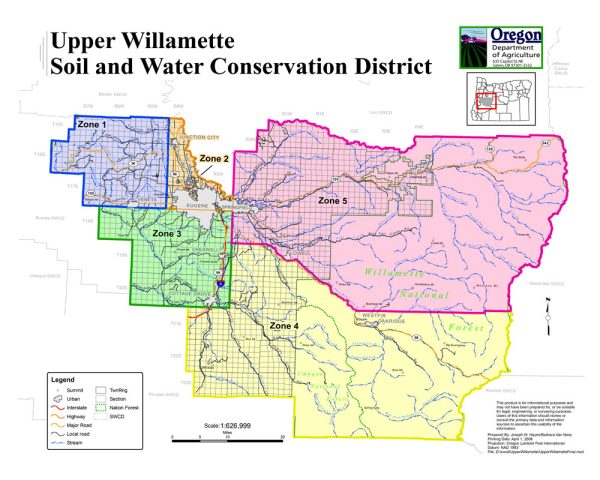
Three board positions are up for election on the Upper Willamette Soil and Water Conservation District. One director says it’s one of the most vital roles in our democracy.
Al Hrynyshyn (Upper Willamette SWCD, Zone 1 director): I look at public service as my role in trying to maintain a healthy democracy that we live in. And any (small-d) democratic society relies on the input and the volunteer efforts of its citizens. And the more citizens are involved in the democratic process, the healthier our society is going to be.
[00:00:31] And so I understand that clean water and healthy soil are two of the three things that all living things need. And we directly provide the services to keep our water clean, we directly provide the services that lead to healthy soils, and indirectly, we affect healthy air quality.
[00:00:49] And to be able to do that and see that by my actions here, such as they are, I’m able to help maintain a government and a society that’s managed by the people, for the people. And I get a great deal of satisfaction out of that.
[00:01:03] You know, I was always one that kind of bagged on the government, like, ‘Well, you know, what are they up to?’ And, ‘They don’t really serve my needs,’ and ‘No one’s listening to me. I’m a little guy, who cares about me.’ Well, I’m able to turn that around.
[00:01:15] And one of my goals of board service is to show that effective government really starts at the very bottom levels. We’re one of the lowest rungs of government and everyone thinks that, ‘Well, that doesn’t sound good.’ No, it’s great! This is where the action happens. And by concerned citizens getting involved and being willing to donate some time and some brainpower and really try to make a difference in the world around us, I think we’re the ones that actually do that.
[00:01:40] And so I’m very proud of the service that I do, not only from the conservation point of view, but every time I do something district-related, I have a little bit of satisfaction that, ‘Yeah, I’m helping make the state of Oregon, the county of Lane, my little neighborhood I live in, heck, the whole United States, I’m making it a little bit better place for all of us.’
[00:02:00] And to me, that’s a hugely important role that I think sometimes gets overlooked. But just making things better for all of us is a goal that I have, and I feel like conservation work helps get that done.
[00:02:12] John Q: So what happens at a soil and water conservation district?
[00:02:18] Terry Preeg-Riggsby (West Multnomah SWCD): Soil and Water Conservation Districts are what we call a special district. So we are a public entity and a non-regulatory government agency that uses public dollars, whether those come from the state or the federal government, through government, through the Department of Agriculture, or some of our districts also collect property taxes.
[00:02:42] Generally soil and water conservation districts were developed during the Dust Bowl. And they were to keep agricultural land from blowing away in the dust. So we wanted to make sure that there was adequate water and healthy soils, primarily originally for agriculture, and that is still our goal.
[00:03:00] There are soil, water conservation districts across all of the United States as well as U.S. territories and we are focused on water quality and quantity and soil health for agricultural production, carbon sequestration, stormwater management in urban areas, and a whole host of other conservation practices.
[00:03:23] Some folks might be, might ask, ‘Well, if soil and water conservation districts were originally established to work with the agriculture community, why would you, in such an urban area, be interested in even serving?’ And that’s a great question, but really the intent is to have conservation practices on every acre for every person throughout the country, and that applies to my district as well, which is urban.
[00:03:49] So, I started out by volunteering with a local watershed council and I got really involved in riparian restoration and salmon habitat restoration as well as stormwater management, so that we could slow down stormwater so that it would be able to absorb into the earth, refill, get down to the water table. It would be cool and clean once it got out to our streams and then eventually to the Willamette River, and it would be healthy for salmonid species. And so that’s salmon and then, you know, we were also looking at lamprey.
And I began working with our soil and water conservation district, which was West Multnomah, and I realized the value of partnerships and working together because we are more powerful when we work together. And I encourage folks to really consider running for this and serving in the community in this way.
[00:05:01] Jasmine Zimmer-Stucky (East Multnomah SWCD): If you’re wondering about what the roles and responsibilities of being a district director is, look on the Oregon Department of Agriculture website. There’s a guidebook for you and Chapter Three has everything you need to know.
[00:05:14] I encourage you to read it a few times just to make sure that, you know, what the responsibilities are are really resonating with you but if I was going to sum it up I would say, you know: ‘The board’s responsibility at a big-picture level is to provide high level guidance and decision-making for your district through processes like annual and long-range planning and crafting and approving the budget.’ Big-picture stuff.
[00:05:42] Decisions are made by a majority vote, though even minority voices do make an impact.
[00:05:47] It’s really important that board members keep the mission of the district, the strategic plan, and other guiding documents in mind at all times when considering plans and proposals that come before the staff, to make sure that all programs are staying within the strategic plan and serving the mission.
[00:06:07] John Q: Jasmine first did a little bit of research.
[00:06:10] Jasmine Zimmer-Stucky: So prior to deciding whether it was right for me, I attended a few board meetings. I read through, you know, a year plus worth of minutes to make sure that I understood what the board really did and who I would be serving alongside.
[00:06:25] And through this, I was able to confirm that I really did care a lot about what the district was doing. You know, it’s important because most of the work of a district director is administrative. You’re not out in the field doing a lot of work. It’s meetings, it’s approving agendas, it’s crafting policies, it’s work sessions, diving into topics.
I can see the big picture of how sitting through a few meetings a month does fit into the larger scale of soil and water health, you know, combating climate change, and advancing equity. For me, it’s important to recognize that there’s many paths to achieved climate resiliency and I support the non-regulatory approach of the soil and water conservation district.
[00:07:06] John Q: You can find the 2024 candidate packet online.
[00:07:11] Lisa Kilders (Clackamas SWCD): So once you get your packet, you will find there’s two forms you’re going to really want to pay attention to.
[00:07:18] The first one is the petition form. You need to ask or get signatures from at least 10 registered voters in your county and then you need to take that form to your county elections office. They will verify that the people who’ve signed your forms are actually voters. And then once they do that, you need to get that back from them, because they will not send that to ODA (Oregon Department of Agriculture). You can go ahead and get started on this right away. That gives you a little extra time.
[00:07:50] The other candidate form is called, ‘The Candidate Declaration of Candidacy.’
[00:07:55] But don’t submit it until July 18. Any time between the 18th of July and Aug. 27 at 5 p.m., they will accept those, and then you will be set to be on the ballot.
[00:08:09] John Q: The 10 signatures can be from anyone in the district, even if you’re running for a specific zone. Whether elected within a zone or at-large, you always represent the district as a whole. A reminder to get started right away on the signatures:
[00:08:25] Al Hrynyshyn (Upper Willamette SWCD): If you’re filling out your forms and need to get them to the county clerks, don’t wait too long to do that. Make sure you get your forms in in plenty of time to get them back because you have to send them to Sandi (Hyatt at the Oregon Department of Agriculture) and so it’s sort of a two-stage process.
[00:08:39] We actually had a board member in our last election that didn’t get her paperwork in on time, and so she had to run as a write-in candidate, which, didn’t matter in the end, but if you’re going to be race that’s contested, if you don’t get on the ballot, you probably aren’t going to make it. So do not put this process off too long.
[00:08:57] John Q: With more about the Upper Willamette district:
[00:09:01] Dave Downing (Upper Willamette SWCD): Hi folks, I’m Dave Downing. I’m the district manager with the Upper Willamette Soil and Water Conservation District.
[00:09:06] We’re located in Lane County. Our district is about 1.9 million acres in size. A lot of it is in federal lands to our eastern boundary. We have five zones and two at-large. And right now we will be having three different zones coming up for our election process.
[00:09:35] We just received a tax-based funding structure in 2020, started receiving funds in 2021. And so we’re really trying to grow and we’re going through a transition and it would be great to have new and diverse ideas and thinking involved in our board.
[00:09:57] Our urban center is Eugene and Springfield with about a constituency of 350,000 people. And then we have our urban centers running down south to the I-5 corridor with Creswell, Cottage Grove, we have Junction City to the north, and so we have a diverse amount of agricultural areas within our zones.
[00:10:25] We are highly involved in soil health. We have a very strong partnership network within our district that we work with, a lot of different conservation entities. And so we just want to build on that and continue to grow our district and to be better stewards of the land.
[00:10:47] John Q: With more about the partnerships:
[00:10:50] Al Hrynyshyn (Upper Willamette SWCD): That’s another thing that’s very unique about what we do. We do not operate in a vacuum, and if you read ORS 568.225, my favorite governmental passage, that’s the Oregon statute that defines what a conservation district is and what our mission is and how we go about doing it. And it specifically mentions that we work in collaborative relationships. It doesn’t mean that everything’s collaborative, but they should be when possible.
[00:11:13] And speaking for what we do in the Upper Willamette and Lane County, we are part of a larger group called the Upper Willamette Stewardship Network and it’s comprised of us but then also several of the major watershed councils and one of the river trust groups that, you know, if you know much about Lane County, you’d recognize their names.
[00:11:31] And they’re our major partners in the projects that we take on and what’s cool about that is, number one, it gets more groups involved and you can share the workload. And it’s when you bring those collaborative groups together to get together and complete these projects, that’s really when good things start to happen. So yeah, collaborative efforts are hugely important to not only our success, but the success of partners as well. It’s an essential part of how we do business.
[00:11:56] John Q: Al says his own seat will be up for election in 2026.
[00:12:00] Al Hrynyshyn (Upper Willamette SWCD): My term will be up in two years, in ’26, and I’m not running for reelection. I’m going to end my public service. And the reason why, it’s not because I’m dissatisfied or anything like that. But I feel that every citizen should have a right to serve on something public.
[00:12:16] And I’m willing to step aside and give someone else a shot because it’s important that every citizen be as involved as possible. So I’ve done what I’m going to do and it’s time to turn it over to another citizen that can do just as good if not a better job.
[00:12:29] John Q: That’s Al Hyrnyshyn from the Upper Willamette Board of Directors. Al and Dave Downing are looking for board members who share a passion for soil and water conservation and for new and diverse ideas on the board and among the district’s many partners.
[00:12:42] Learn more about the district board election, at UWSWCD.org.
[00:12:47] Al reminds us that (small-d) democratic self-governance relies on active participation. And Jasmine Zimmer-Stucky says your ideas will always have impact.
[00:12:57] The website uses the first letters in, Upper Willamette Soil Water Conservation District. That’s UWSWCD.org.
